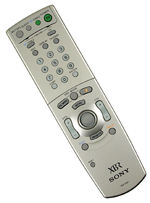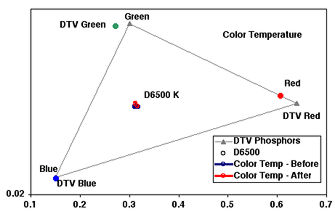Face Off: The Bridge on the River DTV Sony KV-32XBR400
To be honest, I attempted to be overly critical of this set. For the most part, I've only owned Sony televisions, and I didn't want to exhibit any favoritism. It didn't work. This set ended up being the clear winner for me—and Ron and Mike, I might add—and finished in a tie for first for Geoff and as a close second for Maureen. Sony simply knows how to make a damn fine television, and this one proved to be no exception.

I can't go into all the Sony's tricks here, but there are plenty of them. Highlights include a quality line doubler, 1080i and 480p compatibility, an anamorphic mode that automatically senses a compatible DVD and performs the unsqueezing (resulting in a good-sized widescreen window without the loss of resolution that comes with letterboxing), and a trick Sony calls Digital Reality Creation (DRC), which upconverts 480i signals to 960i. The perks of having a 4:3 set with a true 16:9 mode can't be understated. Unless you use a video device only for theater (which you'd probably never do with a 32-incher), the set is still going to see a lot of 4:3 for now. So, unless you'd rather watch a lot of TV with bars on the sides than watch movies with bars on the top and bottom (which we're all accustomed to by now), a hybrid like this is an interesting choice. Consider, too, that you'll still have bars on the top and bottom with most movies on a widescreen set and that the widescreen window on the hybrid 4:3 set is usually only a hair smaller than the usable image on a comparably sized 16:9 set.
 The Sony breezed its way through Video Essentials, showing deep blacks and effective DC restoration (one of only two sets we tested that did so), which determines how the set will adjust black level for light and dark scenes. Thanks to a quality comb filter, the set showed only minor anomalies in terms of cross-color artifacts, dot crawl, and hanging dots. It offered around 450 lines of resolution for NTSC, and its color decoder was very good. Naturally, its reds had Sony's characteristic orange tint, but that was about the only fault we could find with this set—and it's a relatively minor one. The Sony also consistently measured around 6,500 degrees Kelvin on the lowest color-temperature setting, one of only two in this group that did so.
The Sony breezed its way through Video Essentials, showing deep blacks and effective DC restoration (one of only two sets we tested that did so), which determines how the set will adjust black level for light and dark scenes. Thanks to a quality comb filter, the set showed only minor anomalies in terms of cross-color artifacts, dot crawl, and hanging dots. It offered around 450 lines of resolution for NTSC, and its color decoder was very good. Naturally, its reds had Sony's characteristic orange tint, but that was about the only fault we could find with this set—and it's a relatively minor one. The Sony also consistently measured around 6,500 degrees Kelvin on the lowest color-temperature setting, one of only two in this group that did so.
 The set was no less impressive in the real world, knocking out what Ron, Mike, and I all agreed was the best picture of the bunch with DVD material. It was clean, vibrant, accurate, and well-balanced in its detail. There were times with the Gladiator DVD that we all felt the Panasonic appeared to be sharper at a casual glance. Mike pointed out that this was an illusion based on scan-velocity modulation (SVM), which is defeatable on the Sony but not on the Panasonic. Thus, the Panasonic was sacrificing fine detail for the sake of overall detail (which is what SVM essentially does). The difference between the two sets was clear with close-ups of characters' faces. Backgrounds remained sharp on both sets; however, when looking at the face of the dying Caesar, there was considerably more fine detail in the Sony's image. The lines of his face, cut so clearly on the Sony, were washed out and passed over by the Panasonic. Detail is the bottom line in television performance, but balanced detail is the real key.
The set was no less impressive in the real world, knocking out what Ron, Mike, and I all agreed was the best picture of the bunch with DVD material. It was clean, vibrant, accurate, and well-balanced in its detail. There were times with the Gladiator DVD that we all felt the Panasonic appeared to be sharper at a casual glance. Mike pointed out that this was an illusion based on scan-velocity modulation (SVM), which is defeatable on the Sony but not on the Panasonic. Thus, the Panasonic was sacrificing fine detail for the sake of overall detail (which is what SVM essentially does). The difference between the two sets was clear with close-ups of characters' faces. Backgrounds remained sharp on both sets; however, when looking at the face of the dying Caesar, there was considerably more fine detail in the Sony's image. The lines of his face, cut so clearly on the Sony, were washed out and passed over by the Panasonic. Detail is the bottom line in television performance, but balanced detail is the real key.
The Sony didn't differentiate itself quite as noticeably from the pack with the high-def-broadcast images, although Mike, Ron, and I still agreed it had the best picture of the bunch in this respect. It wasn't as though the set's quality fell off in any way; it was more that the other sets' pictures improved considerably with high-def images. The Sony's image was still highly engaging—with crisp lines, deep blacks, and punchy, well-balanced color. Progressive DVD signals also came through without a hitch. While the Sony's image with interlaced output was already smooth and stable, it benefited from the progressive format, as any video display does. Border jaggies and motion artifacts were even less apparent than they were before, and the image maintained a smooth, warm feel that I never expect from a digital source.
The Sony's remote and onscreen menus are also well above par, rounding out what is already a very compelling package. All things considered, the KV-32XBR400 is a relative bargain at $1,999 and should be on your list if you're in this market. Naturally, performance and value are always a tough combination to beat.
Hightlights
• Offers an anamorphic widescreen mode
• Top-shelf performance in every category

HT Labs Measures: Sony KV-32XBR400


The top chart shows the gray scale of the Sony KV-32XBR400 relative to its color temperature at various levels of intensity, or brightness (20 IRE is dark gray; 95 IRE is bright white). As you can see, the gray scale as set by the factory, in the most accurate menu setting, measures within 200 degrees of 6,500 Kelvin across most of the range. After making adjustments using the Photo Research PR-650, the gray scale measures within 40 degrees of D6500 K, the accurate setting, across the entire range. This is excellent. The bottom chart shows the gray scale (or color temperature) relative to the color points of the display's red, green, and blue CRTs. The color points for red and green fall slightly shy of those specified by SMPTE. The red phosphor is a bit orange, and the green phosphor is slightly cyan. The gray scale is nearly accurate, but it leans slightly blue before calibration and is even more accurate afterward. The light output was approximately 30 foot-lamberts with a 15%-white window, representing average picture material. The display could produce 29 ft-L with a full-white image. The display has at least 450 horizontal lines of resolution (per picture height) with NTSC sources.—MW
KV-32XBR400 $1,999
Sony Electronics
(800) 222-SONY
www.sony.com
Dealer Locator Code SNY
- Log in or register to post comments

























































